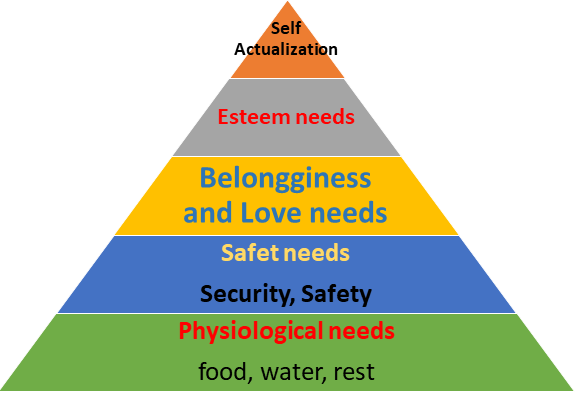The Hierarchy of Needs theory, proposed by psychologist Abraham Maslow in 1943, remains one of the most influential frameworks for understanding human motivation and behavior. Maslow suggested that human needs can be arranged in a hierarchical order, with lower-level needs requiring fulfillment before higher-level needs become motivating factors. In essence, individuals strive to fulfill their basic needs before advancing to higher levels of psychological development and fulfillment.

- Physiological Needs:
At the base of Maslow’s hierarchy are physiological needs, which are fundamental for human survival. These include air, water, food, shelter, sleep, and reproduction. Without satisfying these basic needs, individuals cannot progress to higher levels of development. For instance, if someone lacks food or water, their primary focus will be on obtaining these necessities rather than pursuing personal growth or self-actualization.
- Safety Needs:
Once physiological needs are met, individuals seek safety and security. This includes physical safety, financial security, health, and protection from harm. People desire stability and predictability in their lives, and they strive to create environments that provide these assurances. For example, having a stable job, a safe neighborhood, or access to healthcare satisfies safety needs.
- Love and Belongingness Needs:
Once safety needs are satisfied, individuals seek social connections and a sense of belonging. This includes the need for love, affection, friendship, and acceptance within relationships, families, and communities. Humans are inherently social beings, and fulfilling this need fosters emotional well-being and a sense of connectedness. Building and maintaining relationships, both intimate and platonic, are crucial for meeting this need.
- Esteem Needs:
After fulfilling the lower-order needs, individuals strive for esteem and recognition. There are two types of esteem needs: internal (self-esteem) and external (esteem from others). Self-esteem involves feeling confident, capable, and worthy, while external esteem pertains to receiving respect, recognition, and admiration from others. Achieving success, gaining recognition, mastering skills, and receiving positive feedback all contribute to fulfilling esteem needs.
- Self-Actualization:
At the peak of Maslow’s hierarchy lies the concept of self-actualization, which represents the realization of one’s full potential and personal growth. Self-actualized individuals are characterized by creativity, spontaneity, problem-solving abilities, and a deep sense of fulfillment. They have a clear sense of purpose and are driven by intrinsic motivation rather than external rewards. Self-actualization involves pursuing meaningful goals, embracing personal values, and experiencing profound moments of insight and creativity.
Criticisms and Extensions:
While Maslow’s hierarchy provides valuable insights into human motivation, it has faced criticism and has been subject to various modifications and extensions over time. Critics argue that the hierarchy’s rigid structure may not apply universally across cultures and individuals. Additionally, some psychologists have proposed alternative models that include additional needs or reorder Maslow’s hierarchy.
6 thoughts on “Maslow theory of Motivation”